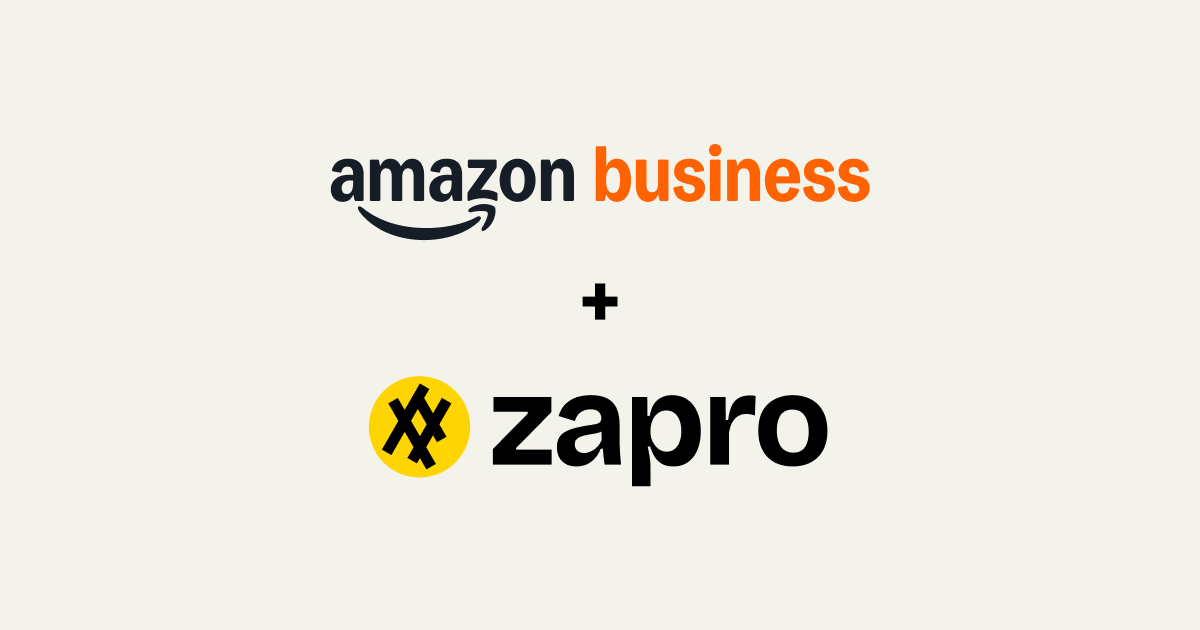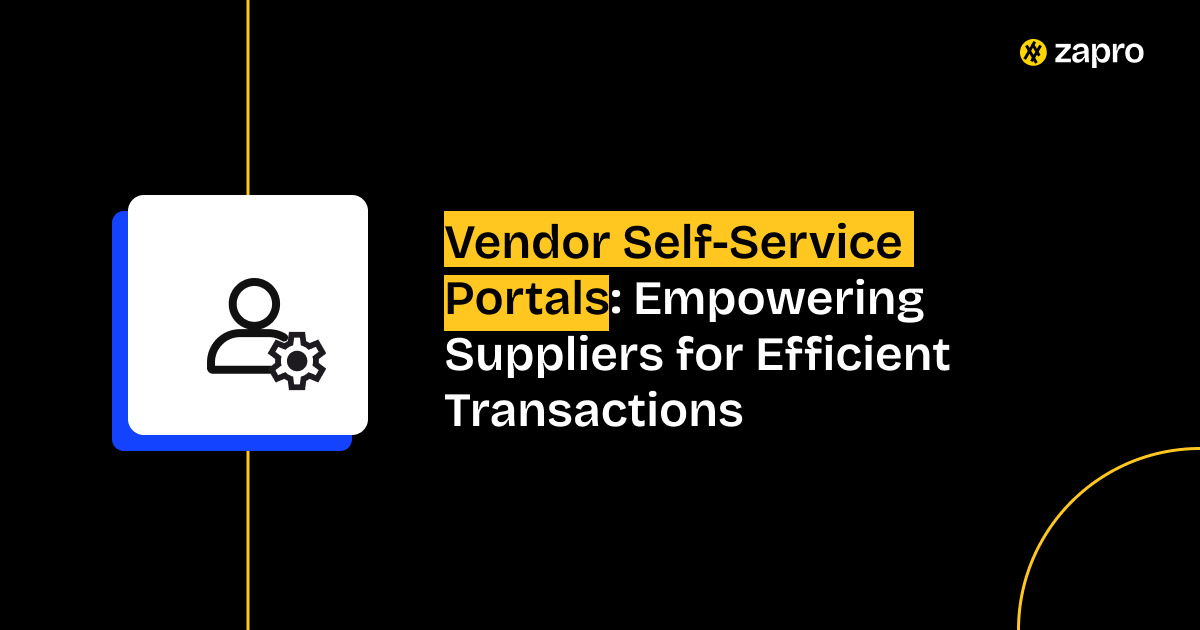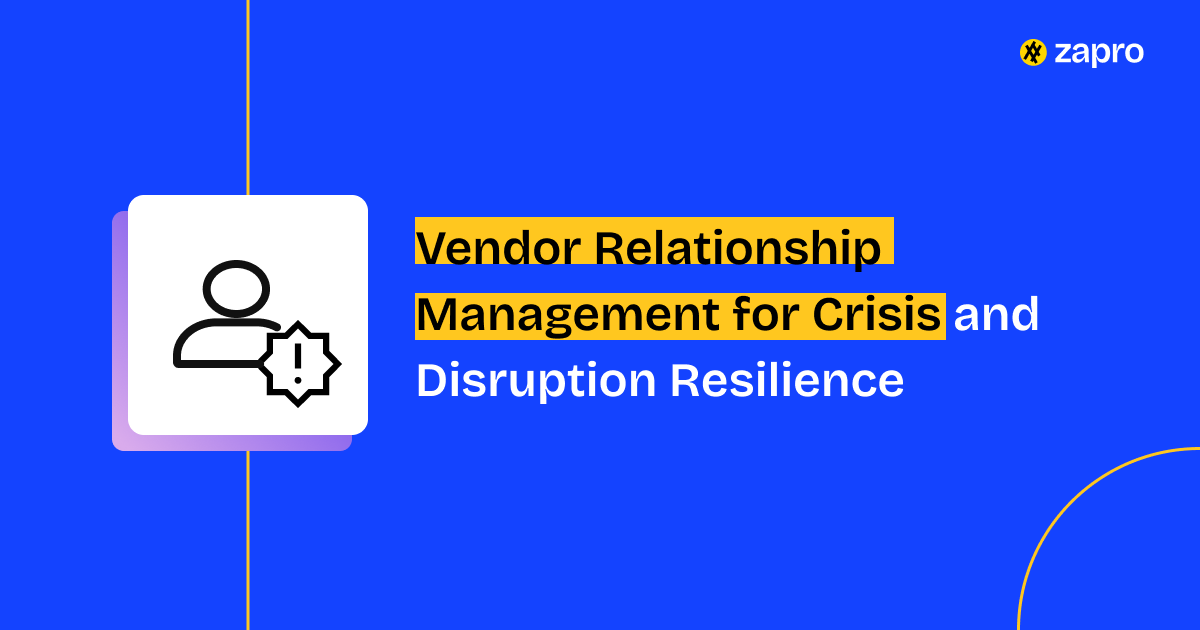Key takeaways
- The implementation of vendor self-service portals removes the need for manual supplier communication which results in time savings for vendors and their internal teams.
- The system performs automated supplier onboarding and invoicing and compliance monitoring which results in better accuracy and faster processing times.
- The system provides instant access to information which builds trust with suppliers and decreases their need to ask about payments.
- The Procure to Pay Process benefits from seamless integration between ERP systems and Vendor Management Systems because it delivers dependable and consistent data.
- The implementation of self-service tools enables organizations to achieve better operational efficiency and improved collaboration and compliance at any scale.
Zapro provides businesses with an integrated platform that streamlines supplier management operations while delivering quantifiable returns on investment.
The evolution of supplier engagement: From manual to self-service
Supplier engagement operated through manual methods for many years by using email threads and phone calls and spreadsheet tracking. The current complex supply networks require suppliers to have better agility and visibility than previous smaller ecosystems did. The management of suppliers has grown to include hundreds and sometimes thousands of vendors who need access to their invoice information and purchase order details and payment status.
The process creates ongoing delays that reduce operational efficiency and decrease team productivity. The transition to self-service supplier portals started because vendors needed independence while internal teams needed reduced administrative work.
The challenges of traditional supplier communication
The current systems for supplier communication lack the ability to handle large numbers of users. The process of receiving invoices and compliance documents and purchase order confirmations involved sending emails and using couriers and making phone calls. The need for human involvement in updates resulted in delayed processing and duplicate work and frequent errors.
Common operational difficulties
The following problems affect procurement and AP teams when they operate with manual systems:
- The number of supplier inquiries about invoice and payment information remains high.
- The process of manual data entry between different systems creates higher chances for record discrepancies.
- The vendors lack access to information about payment schedules and regulatory requirements.
- The team spends most of its time dealing with problems instead of developing strategic plans.
The system produces more than operational inefficiency because it creates significant frustration for users. The supplier experience suffers from lack of attention while internal teams face an overwhelming number of repetitive questions which automated systems could resolve.

Recent analysis by The Hackett Group shows that Gen AI will reduce procurement costs by 47%.
– The Hackett Group Analysis (cited in ZEIV Procurement Statistics 2025)
Why self-service is the future of vendor transactions
The upcoming standard for vendor transactions will depend on transparent operations and collaborative work and mutual responsibility.
A vendor self-service portal enables suppliers to access a single platform which lets them handle their data and track invoices and monitor payment schedules without needing to contact the company repeatedly.
Key benefits of digital supplier interaction systems
Organizations achieve two main benefits through digital supplier interaction systems:
- The system reduces human involvement which results in decreased work for administrators.
- It enables organizations to keep their supplier information and compliance records up to date.
- Plus, the system enables faster and more precise execution of transactional operations.
- It creates trust through its ability to provide real-time visibility to all parties involved.
Self-service platforms deliver dual benefits to suppliers and businesses because they grant vendors independence while organizations gain better control and improved data quality. The adoption of e-procurement for suppliers has made vendor self-service portals the essential platform for managing suppliers at scale.
Key features and benefits of a vendor self-service portal
A vendor self-service portal serves as an essential tool for modern supplier management because it provides vendors with direct access to necessary information and actions while reducing administrative work for procurement and AP teams. The system enables vendors to access necessary information and perform actions independently while procurement and AP teams can focus on other tasks.
The essential elements of these portals make them essential for contemporary procurement leaders to operate.
1. Streamlined onboarding and data management
The system enables vendors to complete their onboarding process and manage their data through an automated process.
- The traditional supplier onboarding process requires extensive paperwork which leads to prolonged delays.
- The system enables vendors to enter their information and upload tax documents and bank details and certifications which then undergo automated verification and approval processes.
- The system enables fast supplier onboarding while maintaining precise data quality which results in uniform information across all systems including ERP and Vendor Management System.
- The system enables procurement teams to handle fewer manual tasks while maintaining accurate supplier information from the beginning.
Insight: Pairing vendor onboarding automation with workflow approvals helps reduce new supplier setup time by up to 60%, accelerating your time-to-transact.
2. Invoice submission and real-time status tracking
The system enables suppliers to submit invoices through the platform while users can monitor invoice status in real-time.
- The system enables suppliers to upload invoices which then get automatically matched with purchase orders while users can monitor the validation and payment status of their invoices.
- The system provides complete visibility to all users which eliminates the need for them to ask about their invoice status.
- The system enables AP teams to process invoices automatically while performing validation checks which results in faster processing and reduced errors.
- The system provides complete visibility to suppliers through e-procurement which enables organizations to enhance their payment cycle efficiency.
3. Purchase order access and acknowledgment
The system enables vendors to access purchase orders through the platform while also requiring them to confirm receipt of these orders.
- The manual process of tracking purchase orders results in delayed communication and lost information and incorrect document versions.
- The vendor portal provides suppliers with direct access to all their purchase orders which they can view and download and confirm receipt of.
- The system enables real-time collaboration between parties which helps prevent disputes from occurring and maintains procurement operations at their scheduled pace.
- The system improves PO compliance rates while optimizing the procure to pay process by eliminating early communication breakdowns.
4. Dispute resolution and communication hub
The system enables vendors to submit disputes through its platform which also functions as a communication hub for all their needs.
- The system enables vendors to submit questions through the platform while uploading supporting documents and monitoring response progress from a single interface.
- The system creates an auditable communication history which enables both parties to resolve issues quickly while maintaining full accountability.
- The system creates trust between suppliers and buyers through its transparent operations which maintain strong relationships in environments with many transactions.
5. Compliance document upload and management
The system enables suppliers to upload their compliance documents which the system then manages for them.
- The system enables suppliers to upload their certificates and licenses and other compliance documents through its interface.
- The system sends automatic alerts for document expiration to maintain continuous compliance while procurement teams obtain immediate access to vendor status updates.
- The system maintains complete audit readiness while ensuring regulatory compliance and eliminating all document-related delays.
| Pro tip: Centralizing compliance tracking in your portal not only strengthens governance but also supports sustainability and ESG reporting initiatives. |
Empower Your Suppliers with Zapro’s Self-Service Portal

How a supplier portal drives efficiency and cost savings
A supplier portal system operates as a system which enhances operational performance while decreasing operational expenses.
A vendor self-service portal functions as a productivity tool which provides more than basic convenience features. Companies achieve better productivity through supplier access to data and documents and status updates which reduces manual work and decreases expenses while strengthening their relationships with suppliers.
The following section demonstrates how these portals create quantifiable operational improvements for procurement and financial management teams.
1. Reducing AP inquiries and administrative overhead
The implementation of self-service supplier portals decreases both AP inquiry volume and administrative work requirements.
- The main advantage of vendor self-service portals becomes evident through their ability to decrease vendor inquiries by a significant amount.
- The AP and procurement teams need to answer numerous repetitive questions about invoice receipt status and payment deadlines and PO reissue requests.
- The vendor portal system provides suppliers with instant access to transaction status information which removes the need for continuous communication with the organization.
- Suppliers can access their account at any time to check payment status and review purchase orders and download payment statements.
- The transition enables teams to dedicate their resources toward essential work including supplier relationship management and process enhancement and strategic procurement initiatives.
- Research indicates that organizations which adopt vendor self-service portals experience at least a 50% decrease in supplier inquiries which directly benefits their AP department operations through time and cost reductions.
2. Improving data accuracy and compliance
The system improves both data precision and regulatory compliance standards.
- The system prevents operational risks by allowing suppliers to handle their own data maintenance which results in perfect data accuracy at all points of contact.
- The correct information suppliers maintain in their profiles results in better operational performance because it reduces payment errors and shortens approval times and enhances reporting accuracy.
- The system performs automatic checks on documents and sends alerts about upcoming expiration dates to help organizations follow their internal rules and external standards.
- The system provides substantial compliance benefits to businesses that need to follow strict audit standards.
- The Vendor Management System and E-procurement Software integration with the portal enables organizations to maintain a unified data repository which prevents duplicate entries and version conflicts between systems.
- The quality of supplier information directly affects your Procurement KPI results because it enhances both procurement cycle speed and decreases the number of Procure to Pay Process exceptions.
3. Enhancing supplier relationships and collaboration
The system enables suppliers to develop better relationships with your organization through its features which promote open communication and complete visibility.
- The system enables suppliers to view the same information as your team members through its self-service interface which establishes trust and removes doubts.
- The system provides complete visibility to both parties which decreases the likelihood of disputes and enables them to work together more effectively.
- The portal includes communication tools which help users solve problems quickly while maintaining complete records of all their interactions.
- The system develops open communication channels which lead to higher supplier satisfaction levels thus enabling better contract terms and preferred pricing and uninterrupted supply delivery.
- A supplier communication platform enables organizations to save time while developing stronger relationships with their suppliers for long-term success.
Implementing a successful vendor self-service portal
Implementing a vendor self-service portal requires equal focus on strategy and technology. The goal is to make it intuitive, well-integrated, and easy for suppliers to use.
1. Defining requirements and user experience
A successful implementation requires organizations to establish precise requirements from the beginning. Your portal needs to address three main problems which include handling excessive inquiries and streamlining onboarding processes and enhancing payment workflow transparency. The system requires three essential features which include invoice tracking and PO acknowledgment and compliance document upload.
- User experience stands as a crucial factor which determines the long-term success of your system.
- The portal needs to provide suppliers with an intuitive interface that works for users at every technical level through simple navigation and step-by-step forms and mobile accessibility.
- The system should enable vendors to perform basic tasks without requiring extensive training.
- The platform’s user-friendly design enables faster adoption while building trust among suppliers regarding your operational procedures.
- The platform achieves better supplier participation when users experience a seamless interface.
- The design stage should include participation from essential suppliers who will provide feedback about usability and layout to enhance workflow development before complete deployment.
2. Integration with existing systems (ERP, VMS)
A standalone portal does not exist in reality. Your vendor self-service system needs to integrate perfectly with all current enterprise systems which include ERP and E-procurement Software and Vendor Management Tools.
- The system maintains real-time data synchronization between different platforms which includes supplier information and invoices and purchase orders.
- The system should automatically update your central systems with supplier bank information changes and compliance document uploads without requiring manual entry.
- The system provides operational advantages through better reporting accuracy and audit simplicity and reduced data duplication.
- The system establishes a single Procurement Life Cycle which tracks all transactions from sourcing to payment with complete transparency.
3. Driving supplier adoption and training
The portal will not generate results when suppliers fail to use it. The success of your portal depends on effective change management and adoption strategies. Your vendors need to understand the portal’s advantages which include faster payment processing and reduced inquiries and real-time access to information.
- The system requires brief training sessions and video tutorials to help suppliers learn how to use it.
- Your procurement team and accounts payable staff need identical training to support suppliers during their onboarding process.
- Your organization should reward suppliers who adopt the portal first by providing them with priority processing and pilot program access.
- The portal will establish itself as the standard communication platform for all vendors in your network after sufficient adoption rates are achieved.
Pro tip: Monitor system usage statistics to detect inactive suppliers so you can start targeted outreach efforts through additional training sessions or direct communication.
Measuring the ROI of your supplier portal investment
A vendor self-service portal delivers its actual worth through quantifiable results instead of basic user convenience. Your organization should monitor three essential performance indicators which include decreased supplier inquiries and accelerated invoice processing and decreased administrative expenses.
1. Key performance indicators (KPIs) to track
Your organization will achieve efficiency gains through the first few months by minimizing manual work and improving supplier data quality and payment processing reliability.
- It should monitor the decrease in vendor inquiries that occur through email and phone contact regarding invoice and payment information.
- It should also monitor the duration needed to handle supplier invoices from receipt to payment completion.
- Plus, they should measure the decrease in administrative expenses which stem from AP and procurement team time savings and reduced manual work.
- The organization should measure vendor satisfaction through survey responses and support ticket evaluation.
- The organization should monitor its progress through tracking data entry mistakes and document errors and payment delays.
2. Long-term business impact
- Your procure to pay process will benefit from improved supplier trust and higher compliance rates which will generate measurable cost reductions.
- The system enables finance teams to maintain transparency while procurement gains better visibility across the supplier ecosystem.
- The portal’s automation of document management, invoice submission, and status updates leads to sustainable productivity gains.
- Vendor collaboration and self-service access help organizations build lasting partnerships and lower operational friction.
| Pro tip: You should set performance indicators before starting implementation to measure process speed improvements and error decreases and supplier contentment levels following system deployment. |
Streamline supplier collaboration with Zapro
Zapro enables organizations to enhance their supplier collaboration processes.
A vendor self-service portal enables suppliers to handle their transactions independently while your staff members can focus on other tasks instead of performing continuous manual work. The system stands out from other solutions because of its unique features.
Zapro enables procurement and finance teams to develop efficient supplier relationships through automated system integration. The following features make Zapro the preferred choice for organizations that lead their industry:
- The system provides vendors with one easy-to-use interface to update their profiles and submit invoices and track purchase orders.
- The system provides suppliers with instant access to view their payment status and receive updates about compliance and order information.
- The system provides easy integration with ERP systems and Vendor Management Systems and E-procurement Software to achieve complete system visibility.
- The system reduces administrative work by performing automated tasks which decrease both supplier inquiries and manual follow-up activities.
- The system maintains accurate supplier data through built-in validation systems and document tracking features which ensure audit readiness.
- The system supports large numbers of vendors through its design which maintains both performance and control at all times.
The supplier engagement platform Zapro enables organizations to create self-managing relationships with vendors which lead to better efficiency and higher satisfaction levels and trust between organizations.
Empower your vendors. Simplify your workflows.
Experience effortless supplier collaboration with Zapro.

Say Goodbye to Manual Vendor Management
Let Zapro’s self-service portal handle order tracking, invoice processing, and supplier communication automatically.
Don’t miss our weekly updates
We’ll email you 1-3 times per week—and never share your information.

 Healthcare
Healthcare Financial Services
Financial Services Technology
Technology Venture Capitalist
Venture Capitalist Chief Procurement Officer
Chief Procurement Officer Chief Financial Officer
Chief Financial Officer




